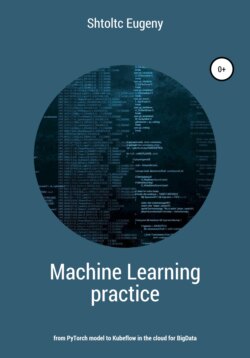Machine learning in practice – from PyTorch model to Kubeflow in the cloud for BigData

Реклама. ООО «ЛитРес», ИНН: 7719571260.
Оглавление
Eugeny Shtoltc. Machine learning in practice – from PyTorch model to Kubeflow in the cloud for BigData
About the book
Introduction Machine Learning
Basics for writing networks
Accelerating learning
Create the first network
Improving the recognition in color images
Getting data from BigData
Data preparation
ML in the cloud
Отрывок из книги
Artificial intelligence is a field at the intersection of many sciences. One of the ways to achieve it is machine learning, when we supply it with data and, on its basis, we learn how to find solutions and identify patterns and data that were not there before. For training, statistical algorithms can be used, for example, in the R language, depth-first search in Prolog or breadth-first search in Refal, as well as adaptive structures – neural networks. Neural networks, depending on the tasks, will hide according to different principles, have a structure and learn in different ways. Recently, the greatest breakthrough has been received by neural networks of data representation (Representation learning), which are engaged in identifying patterns in information, since they cannot remember the information itself due to its size. Deep neural networks with many levels of features give great effects, features at subsequent levels are built on the basis of features from previous levels, which will be discussed in this chapter.
Machine learning (ML) refers to the adaptation of the transformation of input data into outputs, depending on the history of decisions. This class of problems is solved either in an algorithmic way, or with the help of neural networks, and we will talk about where and in what situation it is better to apply what solution. For example, let's take uppercase numbers from zero to nine, which we will compare with printed ones. If the uppercase letters exactly fall into the contour, then everything is simple, we just need to go through the contours of the printed ones and get a suitable option. Such a task is not relevant to machine learning tasks. Now let's complicate the task – our numbers don't exactly match the pattern. If the uppercase numbers do not fit a little into the contour, we just find some kind of deviation. And this is where the difficulty arises when categorizing an uppercase number into zero and nine, when the size of the tail separates the careless spelling of zero from nine. Another point in the categorization of eight and nine. So, if the tip is bent, this is ten, and if it is bent and touches, then it is eight. To solve such a situation, you need to divide the figure into areas and depending on and assign them different coefficients. So, the connection of the tail of the lower part has a very high value than the shape of the circles themselves in the classification into eights and nines. Statistical data on a pre-given sample of the correspondence of figures to eights and nines will help to determine, where the researcher will be able to determine when it is already possible to calculate the lower ring closed and talk about the correspondence of the figure eight, and when not, talk about the correspondence of the nine. But we can programmatically divide the numbers into sectors and assign coefficients to them.
.....
! wget https://www.python.org/static/img/python-logo.png
import PIL
.....